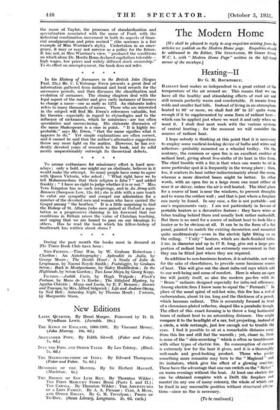The Modern Home [We shall be pleased to reply to
any-enquiries arising from the articles we publish on the Modern Home page. Enquiries should be addressed to the Editor, The SPECTATOR, 99 Gower Street, W.C. 1, with " Modern Home Page" written in the left-hew corner of the envelope.]
Heating II BY G. M. BOUMPIIREY:
RADIANT heat makes us independent to a great extent of the temperature of the air around us. This means that we can have all the healthy and stimulating effects of cool air and still remain perfectly warm and comfortable. It means fewer colds and smaller fuel bills. Instead of living in an atmosphere heated to 60° or more, we shall find 50° to 55° quite warm enough if it be supplemented by some form of radiant heat— which can be applied just where we want it and only when we want it. I shall deal next week with the various system of central heating ; for the moment we will consider the sources of radiant heat.
I hope nobody is thinking at this point that it is necessary to employ some medical-looking device of bulbs and wires and reflectors—probably mounted on a wheeled trolley. On the contrary, the common or open fire is an excellent emitter of radiant heat, giving about five-sixths of its heat in this form. The chief trouble with a fire is that when one wants to sit in some particular spot it is frequently in the wrong place ; then, too, it scatters its heat rather indiscriminately about the room, whereas a more directed beam might be better. In other words, with an open fire in a large room one must either sit near it or shiver, unless the air is well heated. The ideal place for a source of heat is near the windows, to prevent draughts and to warm the coldest wall ; and that is just where a fireplace can rarely be found. In any case, a fire is not portable—and one's requirements vary. I am not particularly in favour of portable heaters as a decorative feature : they have wires or tubes trailing behind them and usually look rather makeshift. But there is no need for a source of radiant heat to look like a heater or to be obvious-at all. It can be in-the form of a flat panel, painted to match the existing decoration and mounted quite unobtrusively—even in the electric light fitting or on the ceiling. " Unity " heaters, which are dark-finished tubes 2 ins. in diameter and up to -17 ft. long, give out a large pro- portion of radiant heat, and are extremely convenient in that they can be fitted just where they are required.
In addition to non-luminous heaters, it is advisable, not only for the sake of cheerfulness, to provide some luminous source of heat. This will give out the short infra-red rays which add to our well-being and sense of comfort. Here is where an open fire will justify itself, as also the modern gas-fire with its " Beam " radiants designed especially for infra-red efficiency. Among electric.fires I know none to equal the " Ferranti." In place of the usual spiral of red-hot wire, this fire has a rod of
carborundum, about 14 ins. long and the thickness of a pencil, which becomes radiant. This is accurately focused in front
of a chromium-plated reflector, shaped like a parabolic trough.
The effect of this exact focusing is to throw a long horizontal beam of radiant heat to an astonishing distance. One might
eompare it to the headlight of a car, tut projecting, instead of
a circle, a wide rectangle, just low enough not to trouble the eyes. I find it possible to sit at a remarkable distance away from this fire and still feel the warmth ; yet, closer in, there is none of the " shin-scorching " which is often so troublesome with other types of electric fire. Its consumption of current
is extremely low for the heat it gives, and it is a thoroughly
well-made and good-looking product. Those who prefer something more romantic may turn to the " Magicoal " and
its imitators, which give the effect of a glowing coal-fire.
These have the advantage that one can switch on the " flicker" on warm evenings without the heat. At least one electric fire can be obtained complete with a Delft tile fireplace and mantel (in any one of many colours), the whole of which can be fixed in any reasonable position without structural altera- tions—since no flue is necessary.
(To be continued.)










































 Previous page
Previous page